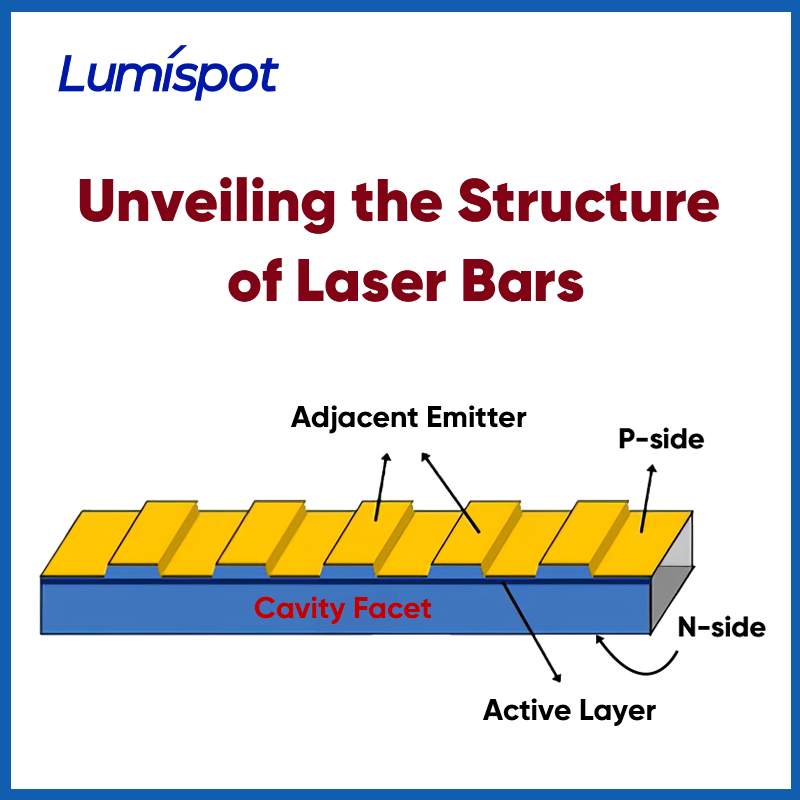In the field of high-power lasers, laser bars are indispensable core components. Not only do they serve as the fundamental units of energy output, but they also embody the precision and integration of modern optoelectronic engineering—earning them the nickname: the “engine” of laser systems. But what exactly is the structure of a laser bar, and how does it deliver tens or even hundreds of watts of output from just a few millimeters in size? This article explores the internal architecture and engineering secrets behind laser bars.
1. What Is a Laser Bar?
A laser bar is a high-power emitting device composed of multiple laser diode chips laterally arranged on a single substrate. While its working principle is similar to that of a single semiconductor laser, the laser bar uses a multi-emitter layout to achieve higher optical power and a more compact form factor.
Laser bars are widely used across industrial, medical, scientific, and defense sectors, either as direct laser sources or as pump sources for fiber lasers and solid-state lasers.
2. Structural Composition of a Laser Bar
The internal structure of a laser bar directly determines its performance. It primarily consists of the following core components:
① Emitters Array
Laser bars typically consist of 10 to 100 emitters (laser cavities) arranged side by side. Each emitter is about 50–150 μm wide and acts as an independent gain region, featuring a PN junction, resonant cavity, and waveguide structure to generate and emit laser light. While all emitters share the same substrate, they are usually driven electrically in parallel or by zones.
② Semiconductor Layer Structure
At the heart of the laser bar is a stack of semiconductor layers, including:
- P-type and N-type epitaxial layers (forming the PN junction)
- Active layer (e.g., quantum well structure), which generates stimulated emission
- Waveguide layer, ensuring mode control in lateral and vertical directions
- Bragg reflectors or HR/AR coatings, which enhance directional output of the laser
③ Substrate and Thermal Management Structure
The emitters are grown on a monolithic semiconductor substrate (commonly GaAs). For efficient heat dissipation, the laser bar is soldered onto high-conductivity submounts such as copper, W-Cu alloy, or CVD diamond, and paired with heat sinks and active cooling systems.
④ Emission Surface and Collimation System
Due to the large divergence angles of the emitted beams, laser bars are typically equipped with micro-lens arrays (FAC/SAC) for collimation and beam shaping. For certain applications, additional optics—such as cylindrical lenses or prisms—are used to control far-field divergence and beam quality.
3. Key Structural Factors Influencing Performance
The structure of a laser bar plays a crucial role in determining its stability, efficiency, and service life. Several key aspects include:
① Thermal Management Design
Laser bars feature high power density and concentrated heat. Low thermal resistance is essential, achieved through AuSn soldering or indium bonding, combined with microchannel cooling for uniform heat dissipation.
② Beam Shaping and Alignment
Multiple emitters often suffer from poor coherence and wavefront misalignment. Precision lens design and alignment are critical for improving far-field beam quality.
③ Stress Control and Reliability
Material mismatches in thermal expansion coefficients may lead to warping or microcracks. Packaging must be designed to distribute mechanical stress evenly and withstand thermal cycling without degradation.
4. Future Trends in Laser Bar Design
As the demand for higher power, smaller size, and greater reliability grows, laser bar structures continue to evolve. Key development directions include:
① Wavelength Expansion: Extending into 1.5 μm and mid-infrared bands
② Miniaturization: Enabling use in compact devices and highly integrated modules
③ Smart Packaging: Incorporating temperature sensors and status feedback systems
④ High-Density Stacking: Layered arrays to achieve kilowatt-level output in a compact footprint
5. Conclusion
As the “heart” of high-power laser systems, the structural design of laser bars directly influences the optical, electrical, and thermal performance of the overall system. Integrating dozens of emitters into a structure just millimeters wide not only showcases advanced material and fabrication techniques, but also represents the high level of integration in today’s photonics industry.
Looking ahead, as the demand for efficient, reliable laser sources continues to rise, innovations in laser bar structure will remain a key driver in advancing the laser industry to new heights.
If you’re looking for expert support in laser bar packaging, thermal management, or product selection, feel free to contact us. We’re here to provide tailored solutions to match your specific application needs.
Post time: Jul-02-2025

